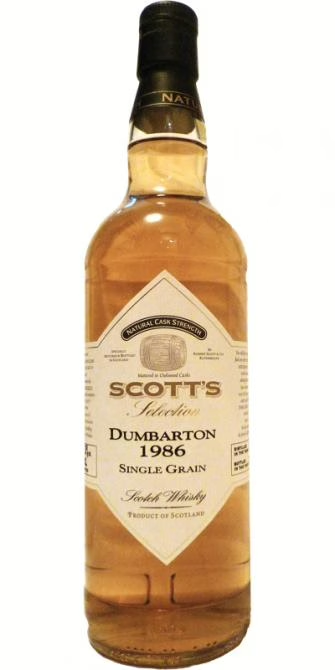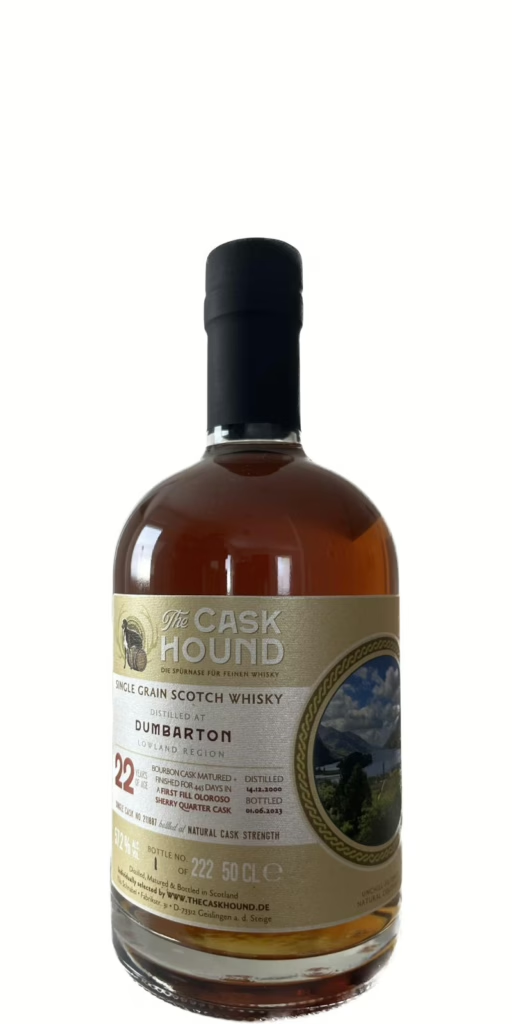Today, the spotlight is on Dumbarton, a closed grain whisky distillery, through two independent single grain releases. First up is a Dumbarton 1986 Scott’s Selection, followed by a more recent bottling from 2000 by The Caskhound. Both offer a rare glimpse into the lightly explored world of Dumbarton grain whisky, ahead of a deeper dive into the distillery’s history after the break.
Dumbarton Distillery
Dumbarton Distillery opened in 1938 as part of Hiram Walker & Sons (Scotland) to supply grain whisky for blending purposes and became the largest grain distillery in Scotland. Located on the site of the former MacMillan shipyard at the confluence of the River Leven and the Clyde, the complex was built with industrial scale in mind, featuring continuous distillation columns, including pioneering American-style stainless steel ones from Vulcan Copper & Supply Co.
Over the decades, Dumbarton has also hosted malt distilleries such as Inverleven and Lomond within its complex. Its whisky primarily contributed to blends like Ballantine’s, and was rarely bottled as a single grain. The distillery operated until 2002 when production was transferred to Strathclyde Distillery due to the high cost of renovation. A distinctive feature of Dumbarton was its ‘Scotch Watch’, a flock of Chinese white geese employed as security guards for the warehouse sites.
Dumbarton produced large volumes of grain whisky primarily for blends but also crafted some single grain bottlings. Initially capable of producing 3 million imperial gallons (around 13.6 million litres) annually, its production capacity expanded to 25 million gallons (approximately 113.6 million litres) per year by the time it closed in 2002. The distillery specialised in maize-based grain whisky using American-style stainless steel continuous distillation columns, differentiating it from traditional Coffey stills employed elsewhere in Scotland.
Dumbarton 1986 Scott’s Selection (2011) Review
This first Dumbarton comes from 1986, bottled in 2011 by Scott’s Selection at cask strength (51.5% ABV). Scott’s Selection typically provides limited details, and in this case, no specific information about the cask type is available. This bottling is long sold out.

Colour:
Deep gold.
Nose:
Neat: The nose opens with honey and glue, followed by corn, coconut, peaches, light caramel, milk chocolate, and a subtle toasted wood note. The intensity remains moderate but pleasant, with an additional hint of corn syrup.
With water: The nose thickens and becomes waxier, revealing light floral and forest notes alongside creamy vanilla nuances.
Palate:
Neat: The palate delivers an intense arrival with vanilla, caramel, substantial pepper, and oak. Flavours of honey spread over peaches and walnuts come through, accompanied by pickled ginger, candied fruit cake, flower petals including nasturtium, dried herbs, and grape skin.
With water: The palate develops a greater oaky bitterness featuring spent tea leaves and coconut shells.
Finish:
The finish is long and peppery, with oak, nutty, and astringent elements lingering.
Comments:
This middle-aged Dumbarton 1986 offers a solid grain whisky experience that doesn’t reach the complexity or depth of a malt. However, it avoids excessive graininess and the harsher notes often associated with grain whisky, making it a commendable selection from Scott’s.
Rating: 6/10
Dumbarton 2000 The Caskhound (2023) Review
Next, we have a Dumbarton distilled on 14 December 2000, bottled by German independent bottler The Caskhound on the 1st of June 2023, matured initially in a bourbon cask before finishing for 445 days in a first-fill oloroso sherry quarter cask #211,887. The bottling produced 222 bottles (500 ml each) at cask strength (57.2% ABV), without chill filtration or added colour. The release was priced around €75 but is now sold out.

Colour:
Ginger
Nose:
Neat: The nose offers abundant caramel, vanilla, and quince jelly alongside charred wood and warm spices like cinnamon and nutmeg. It also carries faint whiffs of solvent and raspberry jam.
With water: After dilution, the nose becomes subdued with dusty wood and distant caramel notes remaining.
Palate:
Neat: The palate is intense and stronger than its 57.2% ABV suggests, presenting brown sugar, caramel, vanilla, and honey with a creamy texture. It features wood, milk chocolate, nuts, and hints of red berries, while the influence of the Oloroso quarter cask remains minimal.
With water: The intensity persists despite the reduction. Some more red fruits appear on the palate, as well as dates and grapes.
Finish:
The finish is short, marked by caramel and vanilla with a generous pinch of pepper.
Comments:
This Dumbarton differs markedly from the Scott’s Selection bottling. It shows little of the typical single grain whisky character, leaning more towards a bourbon style. Blind tasting would hardly reveal its finish in a first-fill oloroso quarter cask; one might suspect a labelling error – though that is unlikely. Overall, it is a nice whisky, albeit with a slightly hot palate.